Ihr Warenkorb ist gerade leer!
Whitepaper Controlling of Assumptions
Controlling of Assumptions
In each strategy definition, assumptions are made on which the development of the strategy is based. Such an assumption may be technological advances such as the digitization. Others are a certain customer behavior towards increasing service demand, economic activity or certain expectations regarding market growth.
The Tasks of assumption controlling are:
Assumption controlling implements a early warning system that detects possible deviations in order to counteract in time.
- The early recognition of external developments that deviate from the assumptions or premises
- Impact Assessment for both qualitative (eg paradigm shift in customer behavior leads to shifts in demand on distribution channels) and quantitative (impact on target revenue, cost items and market shares)
- Introduce corrective action to adapt the strategy to new circumstances
Creating an assumption controlling:
1. Working out the assumptions
First, we compile those assumptions / premises that play a role in the future development of the company. We assign these premises as follows:
- Environment:
- Society, nature, technology and economy
- Stakeholders:
- Customers, employees, suppliers, investors, competition, public, goverment
We have put together a list of topics. It is the same list from which we also compile the main trends for the SWOT:
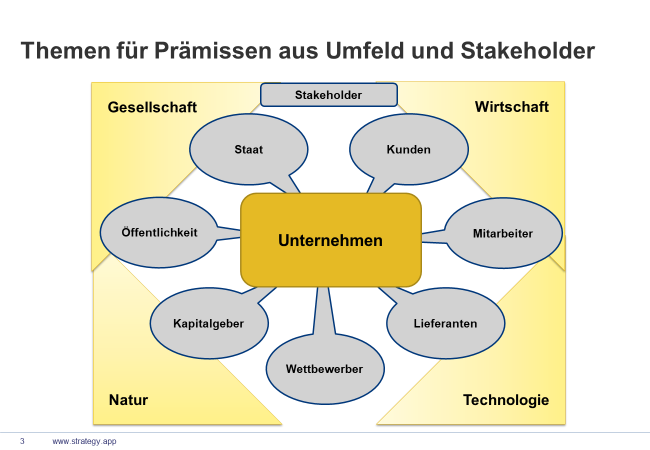
Economic environment:
- Global development / economic development of individual regions or national economies
- Fluctuations in international currencies and interest / inflation rates Rise / decrease of country-specific risks
- Customs duties and tariffs / International trade barriers
- Economic integration, e.g. Eurozone
Technological developments
- Development of key technologies
- Digitization / Internet of Things
- New technologies as a tool of rationalization
- Substitution Technologies / Disruptions
Ecological environment:
- Use of raw and auxiliary materials / recycling
- Sustainability / energy consumption
- Environmentally friendly operating processes
- Wastewater and exhaust air purification / heat recovery
Politics:
- Form of government / stability / legal certainty
- Foreign investment law / tax and depreciation law
- Transfer of capital / credit conditions
- Party political development / possibility of lobbyist influence
- Foreign policy development, conflicts, wars
- Increasing government intervention in the economy
Legal Development:
- Law changes / changes in regulatory competence
- Labour law / consumer protection
- Restrictions on competition
Demographic development:
- Population / population structure / age structure
- Number of households / consumers / size and structure of households (single and multi-person households)
- Level of education
- Urban / rural population
Social development:
- Leisure habits / change of values / consumption habits
- Safety conditions / risk tolerance
- Qualification level and educational development
- Social mobility
- Income distribution / structure of household expenditure
Customers:
- Market development / market share
- Target groups / market segments
- Distribution channels per product / product group / dealer and other customer intermediaries
- Customer problems and needs (incl. solutions) and demand behavior
- Changes of value norms and settings of the customer
- Customer sensitivity regarding price and condition changes
Suppliers:
- Stocks and supply of essential products
- Inventories and supply of operating and auxiliary materials
- Options for the substitution of raw materials, consumables and auxiliary materials
- General developments in the procurement market
- Development of transport prices and costs of supply chain
- Dependency on suppliers
Employees:
- Recruitment costs and challenges / salary levels and trends
- Development of legal benefits
- Union activities and demands
- Reduction and flexibility of working hours
- Education and skilled workers
Investors:
- Sources of capital raised
- Rules on raising and transferring capital
- Foreign exchange rates and interest rates
Public institutions:
- Legislator
- Government authorities
- Local authorities
- Unions
Media / NGOs:
- Public agenda and interests – e.g. human rights / climate change
- Common interests
Competitors:
- Existing competitors (by product group / market segment)
- Potential new competitors – same industry / other industry
- Market entry barriers (norms, laws, etc.)
- Degree of rationalization / use of new technologies or goods
- Innovation capacity and flexibility
We select the trends from this list and evaluate them with relevance: How important is this trend for our company? A short description will help you later to understand exactly what is meant.
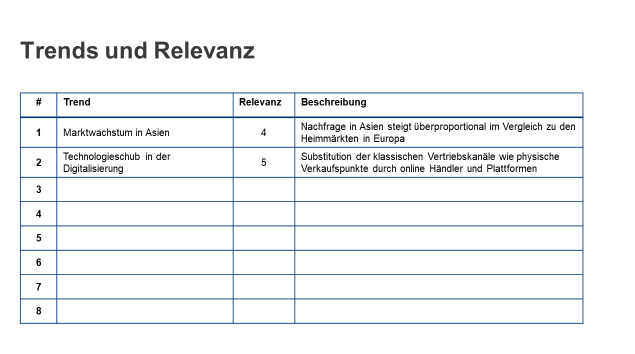
Notice::
The rule plus/minus seven also applies here. Limit yourself to one page, and if you write a little larger, it will be full with 10 trends. We want to limit ourselves to a number that is manageable and therefore controllable. The art of selection is to determine the essential trends that make up the majority of possible changes. It is a matter of selecting those influential variables which, from today’s perspective, are the significant drivers for the future development of the environments, markets, products, customers and suppliers.
2. Measurands and assumptions
Now we form the assumptions and define the measurement parameters – how to measure or assess – and provide them with assumptions for the planning period. The time horizon here is three to five years, sometimes even less, depending on the industry or assumption. An example from one of our projects looks like this:
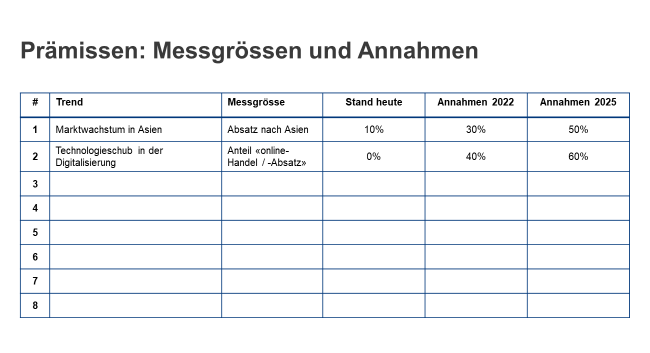
Figure 3: Determine measured variables and make assumptions
3. Precision, method and instrument for controlling
We prepare the controlling by refining the templates and describing the procedure. We will give you a few hints, which you can fill in and define as required.
Data collection
- We will collect the data – who is responsible
- What are the data sources and how should the data format be
- How often are the data collected?
Data analysis
- Describes «what happens if the expected values are not met» – does it concern the whole company or only one business area?
4. Controlling of assumptions / early warning system
The current status of all assumptions is recorded periodically and evaluated with regard to the strategy. The system also checks whether new or other external factors or events affect strategy implementation.
This raises questions such as:
- Did the economic data develop as expected?
- Has the technological development for substitution gone so far that the new basic technologies can be used?
- Are the conditions for market entry in China still good?
- Are customer behavior and demand for the new service developing according to the assumptions made in the strategy process?
- How far is the main competitor with innovative product development? Are we still one step ahead?
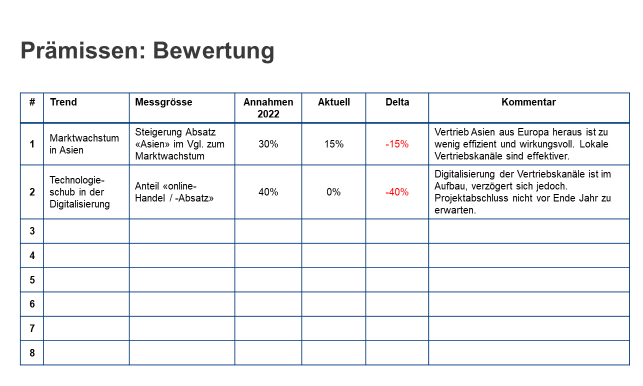
From assumption controlling to early warning system
It may well be that certain assumptions have been out of date since the last adoption of the strategy, or that new conditions have emerged that are relevant to the strategy’s implementation.
The 360° radar serves to keep a comprehensive eye on developments around the company, but also within it. The process responsibility for this task lies with the corporate development or the department that we call strategic planning. To ensure that all relevant facts are recorded and taken into account, however, the entire company must be involved. This can be done, for example, by systematically requesting or delivering market-related information from the sales department. A monthly feedback round serves as an instrument to keep the flow of information from the market going. For example, a company holds an open telephone conference every Monday. Sales staff can share their news for one hour. The procedure is organized in such a way that everyone joins in when and as soon as they can. There is no agenda and no discussion. Information is passed on as in an informal coffee break. After some time, this has meant that employees are eager not to miss this «meeting» because it is here that the most important news is exchanged.
Strategically relevant information is systematically collected and tracked in order to make any necessary adjustments or initiate measures.
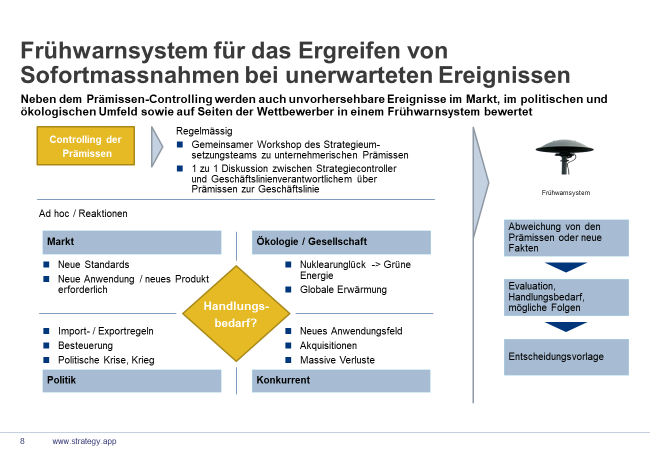
Systematic market, competitor and customer research is part of this process. In addition, technological topics and news from the field of innovation management can be included.
The capture, filtering and exploitation of the information is then the responsibility of the strategy planning department. For events that require immediate response, the early warning system is turned on (see below); further facts are recorded and incorporated into the strategic review meeting.
5. Development of corrective measures
If deviations relevant to the strategy have been identified, the effects on the strategy must be assessed and the need for action evaluated. The same applies to new influencing factors which have been identified and analyzed in these assessment and evaluation steps.
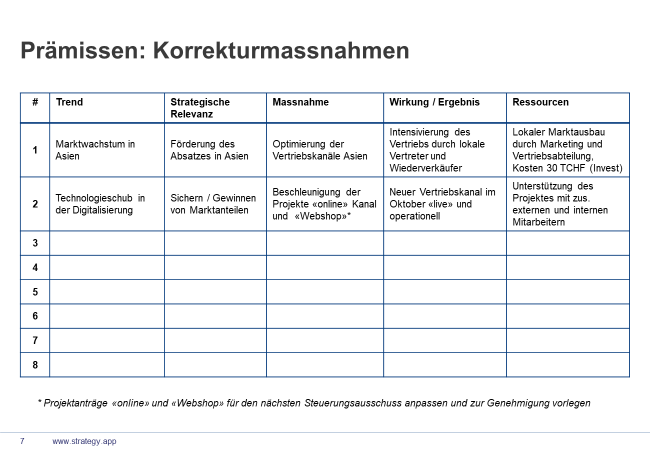
The deviation is documented for each premise and the new influencing factors requiring action are evaluated and proposals for corrective measures are developed.
This work is carried out periodically, e.g. every three months or once a year. This ensures that strategy implementation is always based on relevant assumptions and that new influencing variables are identified in good time.
Basic remark
The growing complexity and uncertainty of market and industry developments presents strategic controlling with new challenges. Focusing on a detailed situation analysis and high-level preview methods is only one part of the work. So-called future scenarios are not used to illustrate what will be, but, what could be. The aim is not to predict a future as accurately as possible, but to form the scenarios that are decisive for the implementation of the strategy with the targeted recognition of external drivers and influencing variables. Using new scenario techniques, excellent early warning systems can be developed and introduced in a targeted manner. In addition, managers and employees are sensitized to important trends and external influences and thus to perform an additional «sensory» function for environmental changes.
We have prepared a Power-Point template for you to download here:
[popup_anything id=»1113″]Schlagwörter:
Schreiben Sie einen Kommentar